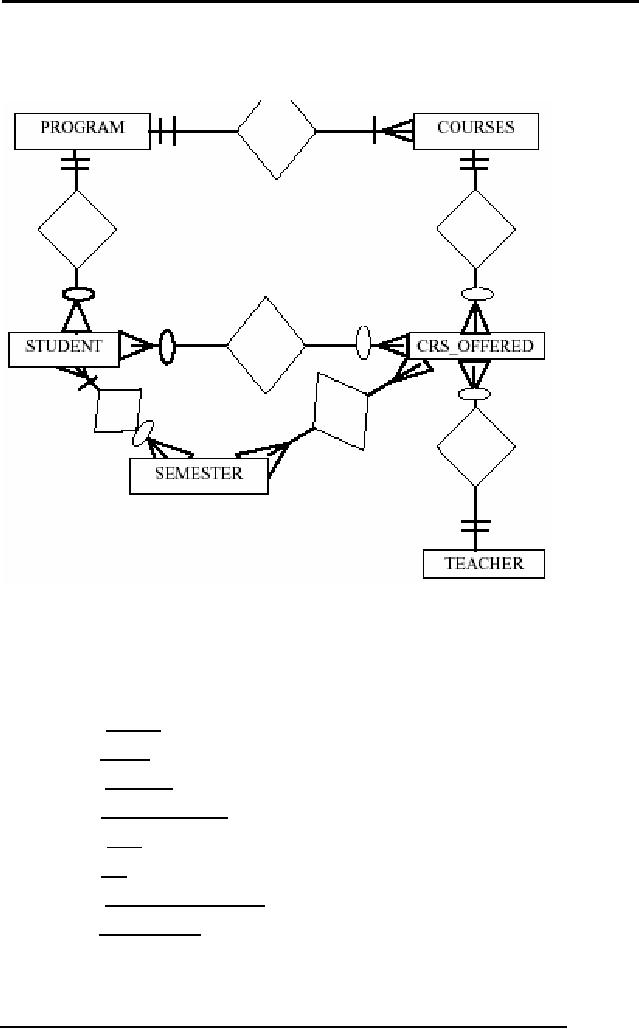 |
Rules of SQL Format, Data Types in SQL Server |
| << Vertical Partitioning, Replication, MS SQL Server |
| Categories of SQL Commands, >> |

Database
Management System
(CS403)
VU
Lecture No.
25
Reading
Material
"Database
Management Systems", 2nd edition, Raghu Ramakrishnan,
Johannes Gehrke,
McGraw-Hill
Overview of
Lecture
o Structured
Query Language (SQL)
In the
previous lecture we have
studied the partitioning and
replication of data. From
this
lecture onwards we will study
different rules of SQL for
writing different
commands.
Rules of
SQL Format
SQL, at
its simplest, is a basic language
that allows you to "talk" to
a database and
extract
useful information. With
SQL, you may read, write,
and remove
information
from a
database. SQL commands can be
divided into two main
sub languages. The
Data
Definition Language (DDL)
contains the commands used to
create and destroy
databases
and database objects. After
the database structure is
defined with DDL,
database
administrators and users can
utilize the Data
Manipulation Language to
insert,
retrieve and modify the data
contained within it.
Following are the rules
for
writing
the commands in SQL:-
� Reserved
words are written in capital
like SELECT or
INSERT.
�
User-defined
identifiers are written in
lowercase
�
Identifiers
should be valid, which means
that they can start with
@,_
alphabets
,or with numbers. The
maximum length can be of
256. The reserved
words
should not be used as
identifiers.
�
Those
things in the command which
are optional are kept in [
]
�
Curly
braces means required
items
�
| means
choices
�
[,.....n]
means n items separated by
comma
Consider
the following
example:-
SELECT
[ALL|DISTINCT]
{*|select_list}
FROM
{table|view[,...n]}
196

Database
Management System
(CS403)
VU
Select *
from std
Data
Types in SQL Server
In
Microsoft SQL ServerTM, each
column, local variable,
expression, and parameter
has a
related data type, which is an
attribute that specifies the
type of data
(integer,
character,
money, and so on) that
the object can hold.
SQL Server supplies a set
of
system
data types that define all
of the types of data that
can be used with
SQL
Server.
The set of system-supplied data
types is shown
below:-
Integers:
�
Biggint
63
Integer
(whole number) data from
2
(-9,223,372,036,854,775,808)
through
263-1
(9,223,372,036,854,775,807).
�
Int
Integer
(whole number) data from
-231 (-2,147,483,648)
through 231
- 1
(2,147,483,647).
�
Smallint
Integer
data from -215 (-32,768) through 215 - 1 (32,767).
�
Tinyint
Integer
data from 0 through
255.
bit
Integer
data with either a 1 or 0
value.
Decimal
and Numeric
�
Decimal
Fixed
precision and scale numeric
data from -1038 +1
through 1038
1.
�
Numeric
Functionally
equivalent to decimal.
Text:
It
handles the textual data.
Following are the different
data types.
�
Char:
By
default 30 characters, max
8000
197

Database
Management System
(CS403)
VU
�
Varchar:
Variable
length text, max
8000
�
Text:
Variable
length automatically
�
nchar,
nvarchar,
ntext
Money:
It is
used to handle the monetary
data
�
Small
money: 6 digits, 4
decimal
�
Money:
15
digits, 4 decimal
Floating
point:
�
Float
�
Real
Date:
�
Smalldatetime
�
datetime
198

Database
Management System
(CS403)
VU
Examination
System Database
Examination
We will
now transfer this conceptual
database design into
relational database
design
as
under:-
PROGRAM (prName,
totSem, prCredits)
(crCode,
crName, crCredits,
prName)
COURSE
SEMESTER
(semName,
stDate, endDate)
(crCode,
semName, facId)
CROFRD
(facId,
fName, fQual, fSal,
rank)
FACULTY
STUDENT
(stId,
stName, stFName, stAdres,stPhone,
prName, curSem, cgpa)
(stId,
crCode, semName, mTerm,sMrks, fMrks,
totMrks, grade, gp)
ENROLL
SEM_RES
(stId,
semName, totCrs, totCrdts, totGP,
gpa)
It is
used to specify a database
scheme as a set of definitions
expressed in a DDL.
DDL
statements are compiled,
resulting in a set of tables stored in a
special file called
199

Database
Management System
(CS403)
VU
a data
dictionary or data directory. The
data directory contains metadata
(data about
data)
the storage structure and
access methods used by the
database system are
specified
by a set of definitions in a special
type of DDL called a data storage
and
definition
language
Data
Manipulation is retrieval, insertion,
deletion and modification of
information
from
the database. A DML is a language,
which enables users to access
and
manipulate
data. The goal is to provide
efficient human interaction
with the system.
There are
two types of DML.First is
Procedural: in which the
user specifies what
data
is needed
and how to get it Second is
Nonprocedural: in which the
user only specifies
what data
is needed
The
category of SQL statements
that control access to the
data and to the
database.
Examples
are the GRANT and
REVOKE statements.
Summary:
In
today's lecture we have read
about the basics of SQL. It
is used to communicate
with a
database. According to ANSI (American
National Standards Institute), it is
the
standard
language for relational
database management systems. SQL
statements are
used to
perform tasks such as update
data on a database, or retrieve data from
a
database.
Some common relational
database management systems that
use SQL are:
Oracle,
Sybase, Microsoft SQL
Server, Access, Ingres, etc.
Although most database
systems
use SQL, most of them also
have their own additional
proprietary extensions
that
are usually only used on
their system. However, the
standard SQL commands
such as
"Select", "Insert", "Update",
"Delete", "Create", and
"Drop" can be used to
accomplish
almost everything that one
needs to do with a database. In
the end we
have also
seen the different types of
SQL commands and their
functions.
Exercise:
Practice
the basic commands of SQL
like SELECT, INSERT and
CREATE.
200
Table of Contents:
- Introduction to Databases and Traditional File Processing Systems
- Advantages, Cost, Importance, Levels, Users of Database Systems
- Database Architecture: Level, Schema, Model, Conceptual or Logical View:
- Internal or Physical View of Schema, Data Independence, Funct ions of DBMS
- Database Development Process, Tools, Data Flow Diagrams, Types of DFD
- Data Flow Diagram, Data Dictionary, Database Design, Data Model
- Entity-Relationship Data Model, Classification of entity types, Attributes
- Attributes, The Keys
- Relationships:Types of Relationships in databases
- Dependencies, Enhancements in E-R Data Model. Super-type and Subtypes
- Inheritance Is, Super types and Subtypes, Constraints, Completeness Constraint, Disjointness Constraint, Subtype Discriminator
- Steps in the Study of system
- Conceptual, Logical Database Design, Relationships and Cardinalities in between Entities
- Relational Data Model, Mathematical Relations, Database Relations
- Database and Math Relations, Degree of a Relation
- Mapping Relationships, Binary, Unary Relationship, Data Manipulation Languages, Relational Algebra
- The Project Operator
- Types of Joins: Theta Join, Equi–Join, Natural Join, Outer Join, Semi Join
- Functional Dependency, Inference Rules, Normal Forms
- Second, Third Normal Form, Boyce - Codd Normal Form, Higher Normal Forms
- Normalization Summary, Example, Physical Database Design
- Physical Database Design: DESIGNING FIELDS, CODING AND COMPRESSION TECHNIQUES
- Physical Record and De-normalization, Partitioning
- Vertical Partitioning, Replication, MS SQL Server
- Rules of SQL Format, Data Types in SQL Server
- Categories of SQL Commands,
- Alter Table Statement
- Select Statement, Attribute Allias
- Data Manipulation Language
- ORDER BY Clause, Functions in SQL, GROUP BY Clause, HAVING Clause, Cartesian Product
- Inner Join, Outer Join, Semi Join, Self Join, Subquery,
- Application Programs, User Interface, Forms, Tips for User Friendly Interface
- Designing Input Form, Arranging Form, Adding Command Buttons
- Data Storage Concepts, Physical Storage Media, Memory Hierarchy
- File Organizations: Hashing Algorithm, Collision Handling
- Hashing, Hash Functions, Hashed Access Characteristics, Mapping functions, Open addressing
- Index Classification
- Ordered, Dense, Sparse, Multi-Level Indices, Clustered, Non-clustered Indexes
- Views, Data Independence, Security, Vertical and Horizontal Subset of a Table
- Materialized View, Simple Views, Complex View, Dynamic Views
- Updating Multiple Tables, Transaction Management
- Transactions and Schedules, Concurrent Execution, Serializability, Lock-Based Concurrency Control, Deadlocks
- Incremental Log with Deferred, Immediate Updates, Concurrency Control
- Serial Execution, Serializability, Locking, Inconsistent Analysis
- Locking Idea, DeadLock Handling, Deadlock Resolution, Timestamping rules